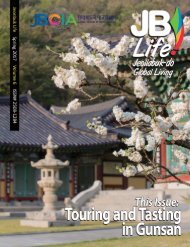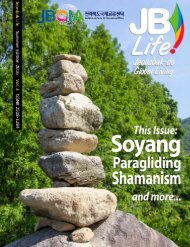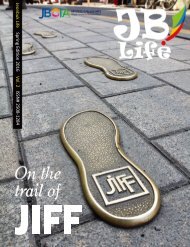JB Life January 2017
Volume 5 (January 2017) of JB Life, a publication of the Jeollabuk-do Center for International Affairs. Enjoy!
Volume 5 (January 2017) of JB Life, a publication of the Jeollabuk-do Center for International Affairs. Enjoy!
Create successful ePaper yourself
Turn your PDF publications into a flip-book with our unique Google optimized e-Paper software.
Lee Min Hyeok (we’re Lees all around the table, but<br />
not related), who has come along for an interview<br />
about their work, the construction of traditional Korean<br />
hanoks.<br />
We sip our tea on the balcony, watching and waiting<br />
patiently for the specks of white in the trees<br />
around the reservoir to spread their heron wings and<br />
dive into the water. You can’t help but wonder if it<br />
looks as beautiful and graceful from the perspective<br />
of the fish, who are about to become a side dish.<br />
But perhaps the fish have accepted the flow of nature<br />
better than us.<br />
Their work sounds grueling as much as fascinating.<br />
I am enchanted by the description of removing<br />
an ancient rooftop for repairs, but maybe less<br />
so by the choking dust resulting from twenty tons<br />
of mud that has been drying for five hundred years.<br />
This is no exaggeration, it turns out. Forty thousand<br />
pounds of mud is quite standard for the construction<br />
of a hanok roof. I ask more about old materials, expecting,<br />
I think, a similar strain of what I’ve heard<br />
from home of carpenters digging carefully for old,<br />
hand-fashioned colonial nails at destruction sites,<br />
24<br />
much higher in quality and durability than our modern,<br />
machine-produced versions. It takes a while<br />
and a few drawings and phone translations for me to<br />
understand what they are trying to explain about ancient<br />
Korean “nails,” though, which turn out to often<br />
be tight collections of dried reeds. Massive beams<br />
of hard wood that take five strong men to move into<br />
place are held there, for hundreds of years, by tough<br />
little twigs.<br />
BK gestures to the hills sloping all around us and<br />
reminds me that during the war the country was<br />
stripped of trees. I had heard that the Arbor Day tradition<br />
of replanting was waning, as there are about<br />
as many trees as there is room for between the growing<br />
skeletal, ever-taller apartment building invasion<br />
of the landscape. What I hadn’t thought of was what<br />
this means for the age of the overall Korean forest.<br />
There are plenty of forty or fifty-year-old trees,<br />
which is fairly young in tree years. So for hanoks,<br />
stronger, old-growth wood is imported from North<br />
America.<br />
I ask BK if it seems sad to him that the trees aren’t<br />
actually Korean trees. Somehow, I had the impres-<br />
sion that, after a cold waterfall shower in the morning,<br />
the hanok builders would turn around and hug<br />
the nearest tree, patriotically. Not exactly. Traditionalism,<br />
and even Korean pride, aren’t always exactly<br />
what you would expect.<br />
It seems a shame to me, at first, considering the<br />
patriotism the trees might feel. But then I remember<br />
my first flight across the States to the Pacific Northwest,<br />
the ugly brown squares cut out of the beautiful<br />
deep green mountains of old-growth forest. “Kimberly<br />
Clark,” said the woman next to me in disgust.<br />
“It all gets chopped down for toilet paper.” If the<br />
majestic, kind, and furry Douglas firs must come<br />
down, I am much more heartened to see them loved<br />
into a beautiful, harmonious hanok far away than<br />
to become local toilet paper. Globalization can be<br />
bittersweet.<br />
“Too-strict rules make us lose culture,” says BK,<br />
poignantly. He tells me about the struggles of building<br />
projects with hard and fast rules about the tools<br />
that can be used. It does seem to make sense that<br />
the original tools would need to be used to create<br />
an authentic structure. He shows me a picture in his<br />
phone of a terrifically old beam revealed in a recent<br />
restoration project. In front is a fresh, light, probably<br />
North American beam, glided into place next to<br />
an older one that is still strong, but dark with age.<br />
Instead of the pettable, smooth furriness of newly<br />
cut wood, the old beam bears proudly the shine of<br />
thousands of painstaking grooves that were left by<br />
someone who must have spent days shaping it by<br />
hand hundreds of years ago.<br />
It’s hard to say if all Korean traditional builders<br />
would feel the same. Patriotism is strong in Korea,<br />
of course. BK has lived and worked in other<br />
countries, embraced other cultures warmly. Perhaps<br />
he can see from the perspective of the bird and the<br />
fish, and perhaps knows exactly how they can build<br />
their nest.<br />
PHOTOS: [Previous and current pages]<br />
Hanok projects by Byoungkyoung<br />
Lee and his crew. [Photos courtesy of<br />
BYOUNGKYOUNG LEE]<br />
Jeonbuk <strong>Life</strong> 25







